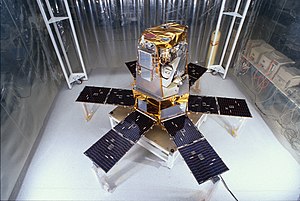Solar Radiation and Climate Experiment
| Solar Radiation and Climate Experiment | |
|---|---|

|
|
| Type: | Research satellite |
| Country: |
|
| Operator: |
|
| Mission dates | |
| Dimensions: | 290 kg |
| Size: | Height: 157.5 cm, diameter: 115.5 cm |
| Begin: | January 25, 2003, 20:13 UTC |
| Starting place: | Eastern Test Range Kennedy Space Center |
| Launcher: | Pegasus XL |
| Status: | Out of service |
| Orbit data | |
| Rotation time : | 97.19 min |
| Track height: | 640 km |
| Orbit inclination : | 40 ° |
| Eccentricity : | 0.0024 |
Solar Radiation and Climate Experiment ( SORCE ) is a NASA satellite observatory that aims to investigate the influence of energy radiation from the sun on the earth's climate and atmosphere. SORCE was part of the Earth Observing Systems .
SORCE continued the long-term measurements of total solar radiation through the Earth Radiation Budget and ACRIM instruments.
construction
The satellite was built by Orbital Sciences Corporation in Dulles , Virginia on behalf of the Laboratory for Atmospheric and Space Physics (LASP) at the University of Colorado Boulder . It is a three-axis stabilized spacecraft with a control system that aligns the satellite to the sun and calibration stars. The dimensions when folded are 100 cm × 160 cm. When the solar panels are unfolded, the satellite has dimensions of 339 cm × 160 cm. The takeoff weight was 290 kilograms. The solar cells deliver an output of 348 watts.
Instruments
- Total Irradiance Monitor (TIM)
- Spectral Irradiance Monitor (SIM) A and B
- Solar Stellar Irradiance Comparison Experiment (SOLSTICE) A and B
- XUV Photometer System (XPS)
Mission history
On January 25, 2003, the 632 kg research satellite was launched with an aircraft-based Pegasus XL . The satellite was operated by the LASP in Boulder. The mission was originally designed for five years, but has been extended. After eight years, battery problems arose so that all-day operation was no longer possible. The planned replacement satellite Glory fell victim to a false start on March 4, 2011. Only the TSIS 1 instrument , which was brought to the International Space Station in December 2017 , was able to carry out equivalent measurements. After a period of parallel operation, NASA made the decision to shut down SORCE. The satellite went out of service on February 25, 2020. The re-entry into the earth's atmosphere was calculated for the year 2032 .
See also
- Active Cavity Radiometer Irradiance Monitor Satellite (ACRIMSat), a satellite with a similar task
- genesis
- Solar and Heliospheric Observatory (SOHO)
- Ulysses
- Earth Observing System
Web links
- University of Colorado: Homepage of the project (English)
- ESA: SORCE (Solar Radiation and Climate Experiment) (English)
Individual evidence
- ↑ a b ESA: SORCE (Solar Radiation and Climate Experiment). In: eoPortal. Retrieved June 19, 2020 (English).
- ↑ Stephen Clark: NASA satellite ends 17-year mission measuring the sun's impact on climate. Spaceflight Now, April 10, 2020, accessed June 19, 2020 .

